Twill fabric is a popular textile known for its distinctive diagonal weave pattern. It is widely used in various industries due to its durability, versatility, and aesthetic appeal.
In this article, we will delve into the characteristics, types, uses, care tips, and sustainability aspects of twill fabric.
What is Twill Fabric?

Twill is a type of textile weave characterized by its distinctive diagonal pattern. Unlike fabrics with a plain weave, where the weft (horizontal) threads pass over and under alternate warp (vertical) threads, twill weave involves the weft threads passing over multiple warp threads before going under one or more, creating a diagonal pattern or ribbing. This weaving technique gives twill fabric its unique texture and appearance.
Twill fabric is known for its durability, strength, and versatility, making it suitable for a wide range of applications. It can be woven from various materials, including cotton, wool, polyester, and blends thereof, offering different properties and characteristics depending on the fibers used.
One of the notable features of twill fabric is its softness and comfort, making it ideal for clothing applications such as trousers, jackets, skirts, and dresses. Additionally, twill fabric drapes well, giving garments a tailored and polished look.
In addition to its use in clothing, twill fabric is commonly utilized in home furnishings such as curtains, upholstery, and bed linens due to its durability and resistance to wrinkles. It is also employed in industrial settings for making protective clothing, bags, and tents, where its robustness is highly valued.
Twill fabric can vary in weight and thickness, ranging from lightweight options suitable for summer garments to heavier varieties used in outerwear and upholstery. It is available in a wide array of colors and patterns, making it versatile for various design preferences and applications.
Twill fabric is a type of textile characterized by its diagonal weave pattern. Unlike plain weave fabrics where the threads cross each other alternately, twill fabrics have a diagonal pattern created by weaving the weft threads over and under multiple warp threads.
History and Origin of Twill Fabric

Twill fabric has a rich and fascinating history that spans centuries and continents. Its origins can be traced back to ancient civilizations, where early weavers discovered the technique of twill weaving by crossing the weft threads over multiple warp threads in a diagonal pattern.
Historical records suggest that twill fabric was first woven in regions such as Mesopotamia and Egypt, where skilled artisans used primitive looms to create textiles with intricate patterns. These early twill fabrics were prized for their durability and versatility, making them highly sought-after commodities for trade and commerce.
During the Middle Ages, twill fabric gained prominence in Europe as advancements in weaving technology allowed for more intricate designs and patterns. Twill became synonymous with luxury and quality craftsmanship, with wealthy aristocrats and nobles commissioning elaborate garments and furnishings made from twill fabric.
The widespread popularity of twill fabric continued into the Renaissance and beyond, with the textile industry flourishing in regions such as Italy, France, and England. Twill weaving techniques were refined and perfected, leading to the production of finer and more intricate fabrics for both domestic and international markets.
In the 19th and 20th centuries, the industrial revolution brought significant changes to the textile industry, with mechanized looms and mass production techniques revolutionizing the way twill fabric was manufactured. This period saw the rise of denim twill fabric, which became synonymous with workwear and casual attire, particularly in the United States.
Today, twill fabric remains a staple in the textile industry, with a wide range of applications across various sectors including fashion, home furnishings, and industrial products. Its durability, versatility, and distinctive diagonal weave pattern continue to make twill fabric a popular choice for designers, artisans, and consumers around the world.
How Is Twill Made?

Twill fabric is made through a weaving process that involves several steps:
Preparation of Yarns: The process begins with the preparation of yarns, which can be made from various fibers such as cotton, wool, polyester, or a blend of different materials. The yarns are spun and dyed according to the desired color and specifications.
Setting up the Loom: The yarns are then loaded onto a loom, which is the machine used to weave the fabric. The loom consists of a frame with a series of parallel threads called the warp, which are held under tension.
Weaving the Fabric: In the weaving process, the weft yarn (horizontal yarn) is passed over and under the warp yarn (vertical yarn) according to a specific pattern. Unlike a plain weave, where the weft alternates over and under each warp thread, twill weave involves the weft passing over several warp threads and then under one or more, creating a diagonal pattern.
Repeating the Pattern: The weaving process continues, repeating the over-under pattern to create the characteristic diagonal ribbing or ridges of twill fabric. The number of warp threads passed over and under by the weft determines the angle and size of the diagonal pattern.
Finishing: Once the weaving is complete, the fabric may undergo various finishing processes such as washing, dyeing, or applying finishes to enhance its texture, appearance, and properties. These finishing steps can also help to improve the fabric’s durability, softness, and color fastness.
What is Twill Fabric Made Of
Twill fabric is typically made from natural fibers like cotton, wool, silk, or linen, or synthetic fibers like polyester or rayon. The distinctive diagonal pattern in twill fabric is created by the way the yarns are woven together. This weaving technique gives twill its characteristic durability and softness, making it suitable for a wide range of garments and household textiles.
What is Twill Fabric Like?
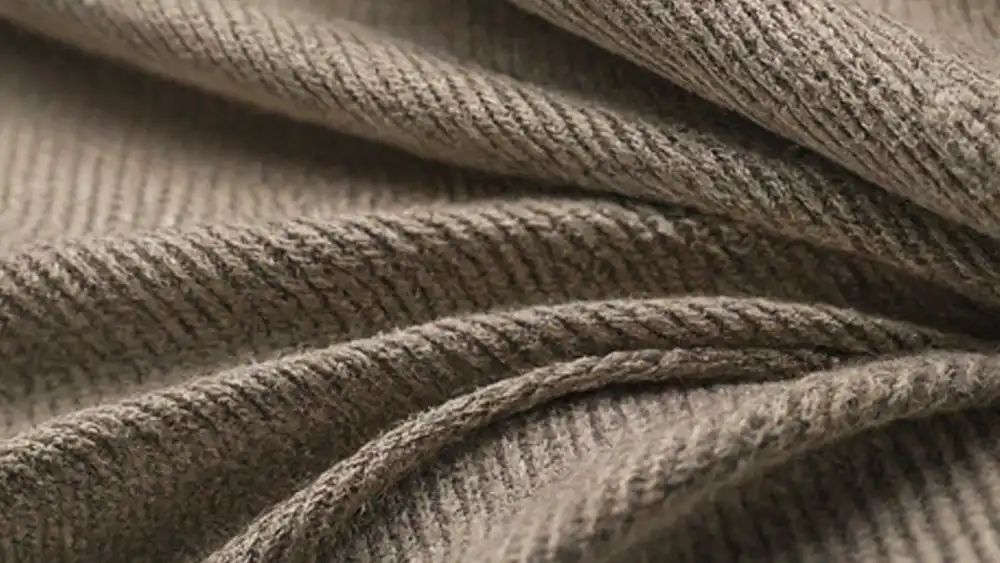
Twill fabric is a versatile textile characterized by its unique weaving pattern, which creates diagonal lines or ridges across the surface. This weaving technique involves passing the weft threads over and under multiple warp threads in a regular pattern. The result is a sturdy fabric with a distinct texture and appearance. Twill fabric can vary in weight, density, and fiber content, offering a wide range of options for different applications. It is commonly used in clothing, upholstery, and various other textile products due to its durability and aesthetic appeal.
What Does Twill Fabric Feel Like
Twill fabric feels smooth and soft to the touch, with a slight texture created by its diagonal weave pattern. When running your fingers over twill fabric, you’ll notice a subtle ribbed texture that adds depth to the material. Despite its sturdy construction, twill fabric remains flexible and comfortable, making it pleasant to wear against the skin. The specific feel of twill fabric can vary depending on factors such as the type of fiber used, the density of the weave, and any additional finishing processes applied to the fabric.
What Does Twill Fabric Look Like
Twill fabric has a distinctive appearance characterized by its diagonal lines or ridges formed by the weaving pattern. These diagonal lines run at an angle across the fabric surface, creating a visually appealing texture. Depending on the type of twill weave and the characteristics of the fibers used, the appearance of twill fabric can range from subtle and understated to bold and pronounced. Twill fabric comes in a variety of colors and designs, offering endless possibilities for incorporating its unique look into clothing, accessories, and home decor items.
Types of Twill Fabric
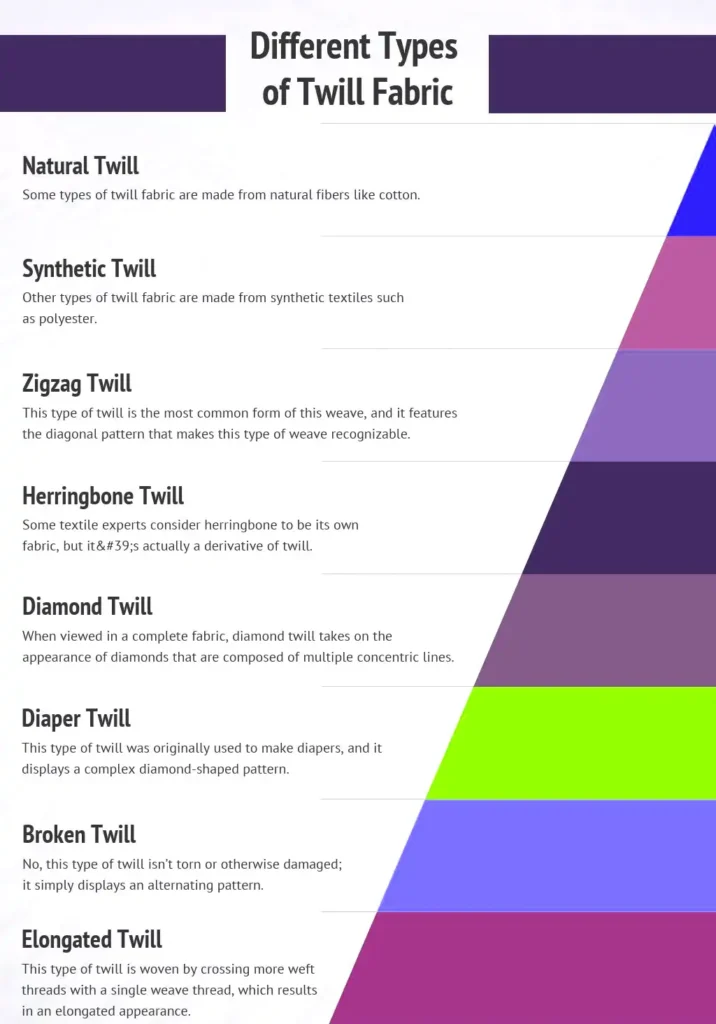
There are several types of twill fabric, each with its own unique characteristics and properties. Some common types include:
Cotton Twill: Cotton twill is a popular choice for clothing and home furnishings. It is made from cotton yarns woven in a twill weave pattern, resulting in a soft and breathable fabric. Cotton twill is known for its durability, versatility, and ability to hold dye well, making it suitable for a wide range of applications.
Wool Twill: Wool twill is prized for its warmth, resilience, and luxurious texture. It is made from wool yarns woven in a twill weave pattern, creating a dense and tightly woven fabric. Wool twill is commonly used in making suits, coats, blankets, and other cold-weather garments and furnishings due to its insulating properties and elegant appearance.
Polyester Twill: Polyester twill is known for its durability, wrinkle resistance, and color retention. It is made from polyester yarns woven in a twill weave pattern, resulting in a smooth and sturdy fabric. Polyester twill is commonly used in outdoor gear, bags, uniforms, and other applications that require a durable and low-maintenance fabric.
Denim: Denim is a type of cotton twill fabric known for its characteristic blue color and diagonal ribbing. It is made from cotton yarns woven in a twill weave pattern, usually with indigo-dyed warp yarns and natural-colored weft yarns. Denim is commonly used in making jeans, jackets, and other casual wear due to its durability and rugged appearance.
Gabardine: Gabardine is a tightly woven twill fabric with a diagonal ribbing on the front and a smooth, flat surface on the back. It is commonly made from wool or polyester yarns and is known for its durability, water resistance, and wrinkle resistance. Gabardine is often used in making suits, trousers, skirts, and outerwear for its tailored look and weather-resistant properties.
What Is Twill Used For?
Twill fabric is used for a wide range of applications due to its versatility, durability, and aesthetic appeal. Some common uses of twill include:
Clothing: Twill fabric is widely used in the fashion industry for making various garments such as trousers, jackets, skirts, dresses, and shirts. Its soft texture, drape, and durability make it suitable for both casual and formal wear.
Home Furnishings: Twill fabric is commonly used in home furnishings such as curtains, upholstery, bed linens, and pillow covers. Its strength, resistance to wrinkles, and wide range of colors and patterns make it ideal for adding comfort and style to interior spaces.
Industrial Applications: Twill fabric’s durability and strength make it suitable for industrial applications such as making protective clothing, workwear, bags, tents, and other heavy-duty products. It can withstand rough conditions and provides reliable protection for workers and equipment.
Accessories: Twill fabric is also used for making various accessories such as bags, backpacks, hats, belts, and aprons. Its versatility and ability to hold shape and structure make it a popular choice for accessories that require both style and functionality.
Uniforms: Many organizations and institutions use twill fabric to make uniforms due to its durability, professional appearance, and ability to withstand frequent washing and wear. Twill uniforms are commonly seen in fields such as healthcare, hospitality, military, and law enforcement.
What is Twill Fabric Good For?
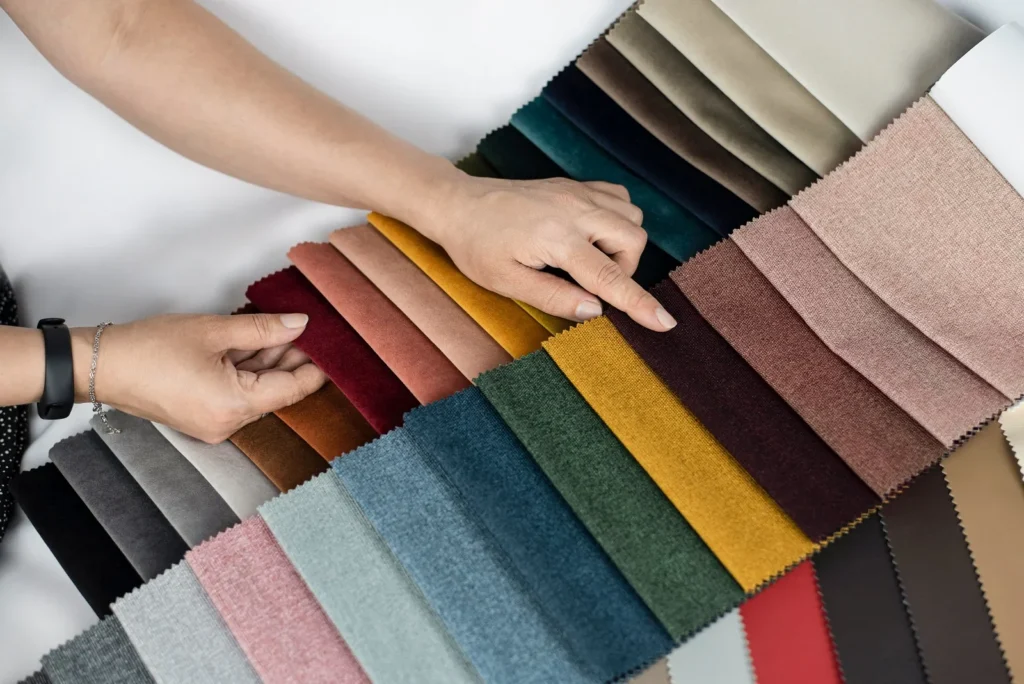
Using twill fabric offers several benefits across various applications:
- Durability: Twill fabric is known for its durability and strength, making it resistant to wear and tear. It can withstand repeated use and washing without losing its shape or integrity, making it a long-lasting choice for clothing, home furnishings, and industrial applications.
- Versatility: Twill fabric is highly versatile and can be woven from various fibers such as cotton, wool, polyester, and blends thereof. This versatility allows for a wide range of applications, from lightweight summer garments to heavy-duty industrial products.
- Comfort: Twill fabric has a soft and smooth texture, making it comfortable to wear against the skin. It drapes well and moves with the body, providing ease of movement and enhancing wearer comfort, especially in clothing applications.
- Resistance to Wrinkles: Twill fabric is resistant to wrinkles and creases, maintaining a neat and polished appearance even after prolonged wear or storage. This wrinkle resistance makes it ideal for garments and home furnishings that require minimal maintenance and upkeep.
- Texture: The diagonal weave pattern of twill fabric gives it a unique texture and appearance, adding visual interest and depth to garments and furnishings. The texture of twill fabric enhances its tactile qualities, making it both visually appealing and pleasant to touch.
- Color Retention: Twill fabric holds dye well, allowing for vibrant and long-lasting colors. This color retention ensures that garments and furnishings made from twill fabric maintain their original appearance even after multiple washes, preserving their aesthetic appeal over time.
- Breathability: Depending on the fiber content and weight, twill fabric can offer excellent breathability, allowing air to circulate freely through the fabric. This breathability makes twill fabric suitable for warm-weather clothing and furnishings, providing comfort and ventilation in hot and humid conditions.
Characteristics of Twill Fabric
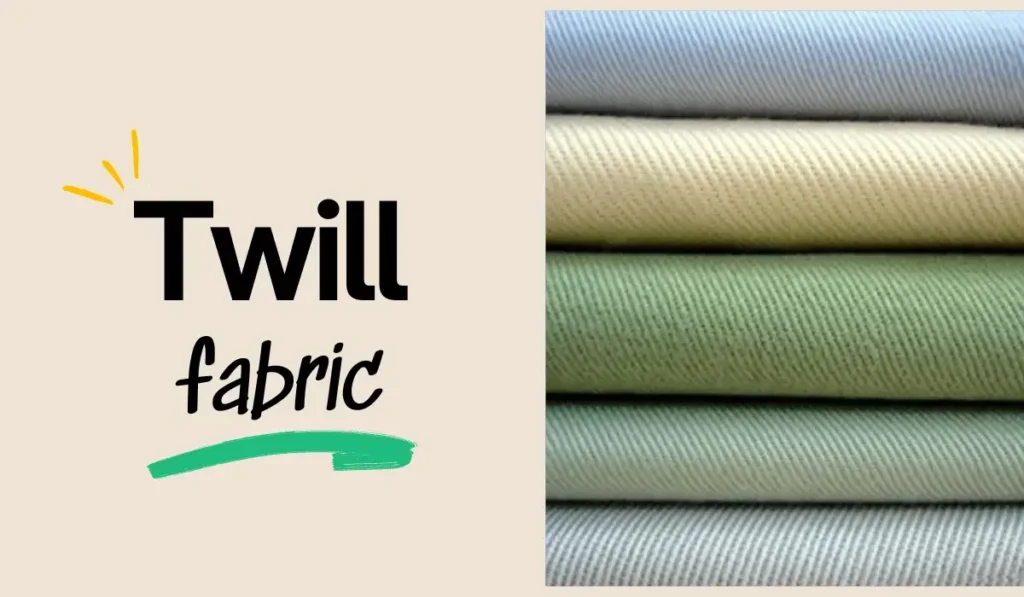
Twill Weave Pattern
The most distinguishing feature of twill fabric is its diagonal weave pattern, which creates a series of parallel ribs or ridges. This characteristic gives twill fabric a unique texture and appearance.
Durability
Twill fabric is known for its strength and durability. The diagonal weave pattern makes it resistant to wrinkles and tears, making it suitable for various applications that require robust textiles.
Texture
Twill fabric has a smooth and soft texture, making it comfortable to wear against the skin. It drapes well and is often used in clothing and home furnishings for its tactile qualities.
Versatility
One of the key advantages of twill fabric is its versatility. It can be woven from different materials such as cotton, wool, polyester, and blends thereof, offering a wide range of options for various applications.
Common Uses of Twill Fabric
Twill fabric finds applications in various industries and products due to its versatility and durability.
Clothing
Twill fabric is widely used in the fashion industry for making trousers, jackets, skirts, and dresses. Its soft texture and drape make it suitable for both casual and formal wear.
Home Furnishings
Twill fabric is commonly used in home furnishings such as curtains, upholstery, and bed linens. Its durability and color-fastness make it ideal for everyday use in households.
Industrial Applications
Twill fabric is also used in industrial settings for making protective clothing, tents, bags, and other durable goods. Its strength and resilience make it suitable for demanding environments.
Pros and Cons of Twill Fabric
Advantages
- Durable and long-lasting
- Versatile and adaptable
- Soft texture and comfortable to wear
- Resistant to wrinkles and creases
Disadvantages
- May shrink if not properly cared for
- Can be prone to fading if exposed to sunlight for extended periods
- Some types may require special care during washing and drying
Care and Maintenance of Twill Fabric
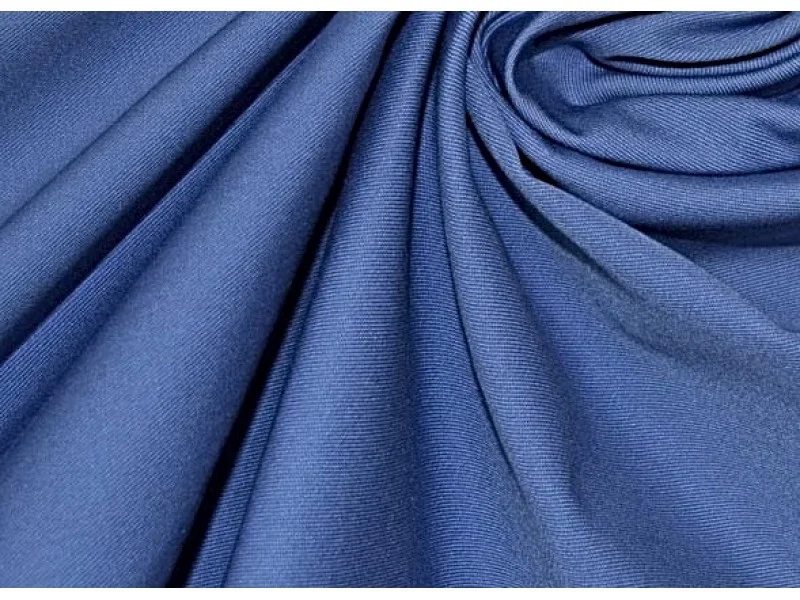
Proper care and maintenance are essential for prolonging the life of twill fabric garments and furnishings.
Washing Instructions
- Machine wash on a gentle cycle with like colors
- Use mild detergent and avoid bleach
- Tumble dry on low heat or air dry to prevent shrinkage
Ironing Tips
- Iron on a low to medium heat setting
- Use a pressing cloth to protect the fabric from direct heat
- Avoid ironing directly on any embellishments or prints
Storage Suggestions
- Store twill fabric items in a cool, dry place away from direct sunlight
- Avoid hanging heavy items on garments to prevent stretching
- Fold neatly to prevent creasing and wrinkles
How to Identify Quality Twill Fabric
Quality twill fabric should have a tight weave, uniform texture, and minimal flaws or imperfections. It should feel smooth to the touch and have good draping qualities. Additionally, high-quality twill fabric should maintain its color and shape after washing and wear.
Sustainable Aspects of Twill Fabric
Twill fabric made from natural fibers such as cotton and wool is biodegradable and environmentally friendly. Additionally, advancements in textile manufacturing have led to more sustainable practices, such as using recycled materials and reducing water and energy consumption during production.
How to Care for Twill Fabric
Caring for twill fabric is relatively simple, but it’s essential to follow specific guidelines to maintain its quality and longevity. Here are some tips for caring for twill fabric:
Washing Instructions:
Machine wash twill fabric in cold or lukewarm water on a gentle cycle.
Use a mild detergent that is suitable for delicate fabrics.
Avoid using bleach or harsh chemicals, as they can weaken the fabric fibers and cause discoloration.
Wash twill fabric separately or with similar colors to prevent color bleeding or fading.
Drying:
After washing, remove twill fabric from the washing machine promptly to prevent wrinkles.
Hang twill fabric to dry or lay it flat on a clean, dry surface.
Avoid wringing or twisting twill fabric, as this can distort its shape and texture.
If using a dryer, tumble dry twill fabric on a low or medium heat setting to prevent shrinkage and damage to the fabric fibers.
Ironing:
If necessary, iron twill fabric on a low to medium heat setting to remove wrinkles and creases.
Use a pressing cloth or ironing board cover to protect the fabric from direct heat and prevent shine or scorch marks.
Iron on the wrong side of the fabric whenever possible to avoid damaging the surface.
Storage:
Store twill fabric items in a cool, dry place away from direct sunlight, moisture, and heat.
Avoid hanging heavy items on twill garments to prevent stretching and distortion of the fabric.
Fold twill fabric neatly to prevent creasing and wrinkles, especially for long-term storage.
Spot Cleaning:
For small stains or spills, spot clean twill fabric with a mild detergent and water.
Gently dab the stained area with a clean cloth or sponge, being careful not to rub or scrub vigorously, as this can damage the fabric fibers.
What Seamwork Patterns Work for Twill?
Several Seamwork patterns are well-suited for twill fabric due to their structure, design features, and ease of construction. Here are some Seamwork patterns that work particularly well with twill fabric:
Ace Jacket: The Ace Jacket is a versatile outerwear pattern with relaxed fit and customizable details such as patch pockets, a drawstring waist, and a zip or button front. It is ideal for twill fabric due to its durability and ability to hold shape, making it suitable for casual jackets and coats.
Everett Trousers: The Everett Trousers are a classic tailored pants pattern with a slim fit, waistband, and optional pockets. Twill fabric drapes well and has enough structure to create crisp, polished trousers that can be dressed up or down for various occasions.
Jasper Sweater/Dress: The Jasper Sweater/Dress is a cozy knit pattern with a relaxed silhouette, funnel neck, and raglan sleeves. While originally designed for knits, the Jasper can also be made in twill fabric for a more structured look, especially when using a heavier-weight twill for colder weather.
Bianca Dress: The Bianca Dress is a versatile pattern with a fitted bodice, optional waist ties, and a full or A-line skirt. Twill fabric can provide structure and stability to the Bianca Dress, allowing it to hold its shape and showcase the garment’s design details beautifully.
Easton Backpack: The Easton Backpack is a practical and stylish accessory pattern with multiple pockets, adjustable straps, and a zip closure. Twill fabric is durable and sturdy enough to withstand the rigors of everyday use, making it an excellent choice for creating a functional and long-lasting backpack.
How Does Twill Fabric Impact the Environment?

Twill fabric, like any other textile, can have both positive and negative environmental impacts throughout its lifecycle.
Here’s how twill fabric can impact the environment:
- Resource Consumption: The production of twill fabric requires resources such as water, energy, and raw materials (e.g., cotton, wool, polyester). Depending on the manufacturing processes and sourcing practices, the extraction and processing of these resources can contribute to environmental degradation, including water pollution, habitat destruction, and greenhouse gas emissions.
- Chemical Usage: The dyeing and finishing processes involved in twill fabric production often require the use of chemicals, some of which can be harmful to the environment and human health. Improper disposal of these chemicals can lead to water pollution and soil contamination, affecting ecosystems and communities near manufacturing facilities.
- Waste Generation: Textile production generates waste at various stages, including fiber processing, weaving, dyeing, and finishing. This waste can include excess fabric, trimmings, and chemical byproducts, which may end up in landfills or be incinerated, contributing to environmental pollution and resource depletion.
- Water Consumption: The textile industry is known for its high water consumption, particularly in processes such as dyeing and finishing. Water-intensive production methods can strain local water resources, leading to water scarcity and ecosystem degradation, especially in regions already facing water stress.
- Pollution: The discharge of untreated wastewater from textile factories can contain pollutants such as dyes, heavy metals, and toxic chemicals, which can contaminate waterways and harm aquatic life. Pollution from textile manufacturing can also impact soil quality and air quality in surrounding areas, posing risks to human health and ecosystems.
- Land Use: The cultivation of natural fibers such as cotton and wool requires agricultural land, which may involve deforestation, habitat loss, and biodiversity depletion. Additionally, the expansion of textile production facilities can lead to land conversion and displacement of local communities and indigenous peoples.
Conclusion
Twill fabric is a versatile and durable textile with a rich history and wide range of applications. Whether used in clothing, home furnishings, or industrial goods, twill fabric offers a combination of strength, comfort, and aesthetic appeal. By understanding its characteristics and proper care techniques, consumers can enjoy the benefits of twill fabric for years to come.
FAQs about Twill Fabric
Is twill fabric suitable for all seasons?
Yes, twill fabric can be woven from different materials, making it suitable for both warm and cold weather garments.
Can twill fabric be dyed easily?
Yes, twill fabric accepts dye well, allowing for a wide range of colors and designs.
How can I prevent twill fabric from shrinking?
To prevent shrinkage, always follow the manufacturer’s care instructions and avoid washing in hot water or using high heat when drying.
Is twill fabric environmentally friendly?
Twill fabric made from natural fibers such as cotton and wool is biodegradable and eco-friendly.
What are some common misconceptions about twill fabric?
One common misconception is that twill fabric is always heavy and thick. In reality, twill fabric can be lightweight and suitable for a variety of uses.
